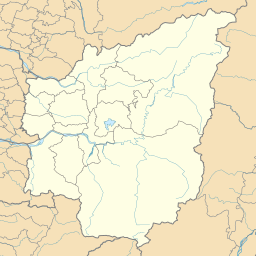| Sun Moon Lake | |
|---|---|
| Lake Candidius Zintun | |
| 日月潭 (Chinese) | |
 Sun Moon Lake captured by Sentinel-2 satellite in 2024 | |
| Location | Yuchi, Nantou County, Taiwan |
| Coordinates | 23°52′N 120°55′E / 23.867°N 120.917°E |
| Type | Lake |
| Primary outflows | Shueili River |
| Surface area | 7.93 km2 (3.06 sq mi) |
| Max. depth | 27 m (89 ft) |
| Surface elevation | 748 m (2,454 ft) |
| Sun Moon Lake | |||||||||||||||||||||
|---|---|---|---|---|---|---|---|---|---|---|---|---|---|---|---|---|---|---|---|---|---|
"Sun Moon Lake" in Chinese characters | |||||||||||||||||||||
| Chinese | 日月潭 | ||||||||||||||||||||
| Literal meaning | "Sun Moon Pool" | ||||||||||||||||||||
| |||||||||||||||||||||
Sun Moon Lake (Chinese: 日月潭; pinyin: Rìyuè tán; Pe̍h-ōe-jī: Ji̍t-goa̍t-thâm; Thao: Zintun) is a lake in Yuchi Township, Nantou County, Taiwan. It is the largest body of water in Taiwan. The area around the lake is home to the Thao tribe, one of Taiwan's aboriginal tribes.[1] Sun Moon Lake surrounds a tiny island called Lalu.[2] The east side of the lake resembles a sun while the west side resembles a moon, hence the name.[3]
Sun Moon Lake is located 748 m (2,454 ft) above sea level. It is 27 m (89 ft) deep and has a surface area of approximately 7.93 km2 (3.06 sq mi). The area surrounding the lake has many trails for hiking.[1]
While swimming in Sun Moon Lake is usually not permitted, there is an annual 3-km race called the Swimming Carnival of Sun Moon Lake held around the Mid-Autumn Festival each year.[4][5] The Sun Moon Lake Swimming Carnival was launched in 1983[6] and is listed among the Top 50 Open Water Swims in Asia and the Top 100 Open Water Swims of the World.[7] Everyone over 10 years old and with the ability to swim long distances can join, regardless of nationality.[8] In recent years, the participants have numbered in the tens of thousands. Other festivities held at the same time include fireworks, laser shows, and concerts.
The lake and its surrounding countryside have been designated one of thirteen national scenic areas in Taiwan. Wen Wu Temple was built after rising water levels from building a dam forced several smaller temples to be removed.[9] Tzu-En Pagoda (慈恩塔; Cí'ēn Tǎ) was ordered constructed by late President Chiang Kai-shek in 1971 in memory of his mother.[10] Other temples of note include Jianjing Temple,[3] Syuentzang Temple[11] (玄奘寺; Xuánzàng Sì) and Syuanguang Temple[12] (玄光寺; Xuánguāng Sì).
- ^ a b "Sun Moon Lake has it all for tourists". The China Post. 2007-12-27. Archived from the original on 2021-01-22. Retrieved 2010-07-27.
- ^ "Lalu Island". Sun Moon Lake National Scenic Area Administration. Archived from the original on 2012-07-28. Retrieved 2010-07-27.
- ^ a b "Jioulongkou". Sun Moon Lake National Scenic Area Administration. Archived from the original on 21 November 2015. Retrieved 9 September 2015.
- ^ "Cross-Sun Moon Lake swim draws record number of participants". Central News Agency. 2009-09-20. Archived from the original on 2016-08-10. Retrieved 2010-07-27.
- ^ "Race at Sun Moon Lake attracts 20,000 applicants". Taipei Times. 2007-09-12. Archived from the original on 2009-05-31. Retrieved 2010-07-27.
- ^ "Sun Moon Lake Swimming Carnival". Sun Moon Lake National Scenic Area Administration. Archived from the original on 2019-01-23. Retrieved 2018-08-01.
- ^ "Sun Moon Lake International Swimming Carnival". Open Water Swimming Race Calendar. Archived from the original on 2018-08-01. Retrieved 2018-08-01.
- ^ "Sun Moon Lake Swimming Carnival". rove.me. Archived from the original on 2018-08-01. Retrieved 2018-08-01.
- ^ "Wenwu Temple". Sun Moon Lake National Scenic Area Administration. Archived from the original on 2014-08-03. Retrieved 2010-07-27.
- ^ "Ci En Pagoda". Sun Moon Lake National Scenic Area Administration. Archived from the original on 18 April 2016. Retrieved 9 September 2015.
- ^ "Syuentzang Temple". Sun Moon Lake National Scenic Area Administration. Archived from the original on 17 April 2015. Retrieved 9 September 2015.
- ^ "Syuanguang Temple". Sun Moon Lake National Scenic Area Administration. Archived from the original on 9 August 2016. Retrieved 9 September 2015.
